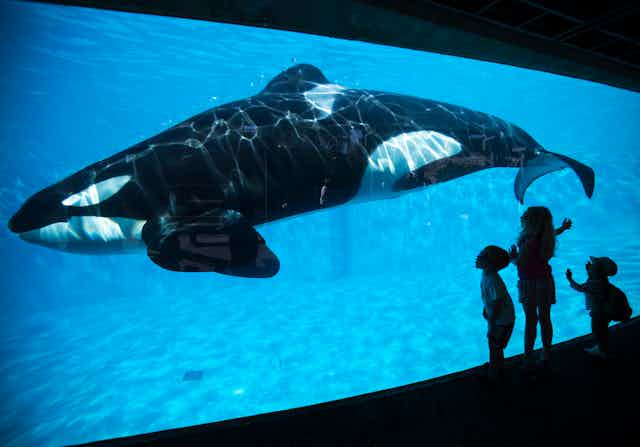SeaWorld in California has announced that it will be phasing out killer whale shows from 2017. The move comes in response to public criticism over the treatment of the whales, heavily influenced by the documentary Blackfish.
Concern over the welfare of captive killer whales raises a much broader question of whether there are animal species that should never be kept in captivity. Many people are concerned about apes and elephants, for instance, because they have highly developed cognitive abilities such as autonoetic consciousness – the ability to see their life as a continuous story.
Back in the 1990s the Great Ape Project set about trying to give apes equivalent rights to humans, which would technically mean that they could not be held in captivity as this would count as unlawful imprisonment. In recent years a number of court cases have attempted to have apes and other species classified as non-human persons under the law.
If a judge accepted this proposition then an animal could be given locus standi meaning that its rights could be represented in a court of law in much the same way as a child can be represented by a lawyer. This happened in Argentina in 2014, when a judge ruled that an orangutan called Sandra at Buenos Aires Zoo was being unlawfully deprived of her freedom. After legal appeals, Sandra will now be sent to an animal sanctuary in Brazil.

So how can we decide if a species should ever be kept in captivity? Philosophers would first apply the “basic needs test”, which questions whether all of the animal’s physiological needs for survival are being provided. That is: does the animal have enough food, water and the correct kind of shelter? All zoos around the world should be meeting this need; if they don’t, their animals would die.
Of course there may be species in the wild whose basic needs are not sufficiently well known for this test to be passed. No mountain gorillas have ever been kept successfully in captivity, for instance, perhaps due to the problems of providing them with an adequate diet and climate.
Equally just because a species can potentially be kept comfortably in captivity doesn’t mean they should be, especially when badly-run zoos or negligent owners are involved. This leads us onto the second test that philosophers would apply, called the “comparable life test” – is the life of an animal in captivity at least as good as it would experience in its natural habitat?
This test is much more difficult to measure because here we are also concerned with the animal’s psychological well-being and so cannot use simple measures such as longevity or reproductive output. Some species, such as elephants, have much shorter lives in captivity, whereas chimpanzees live much longer. Tigers will breed under the most appalling of animal welfare conditions, so much so that they can be farmed, whereas gorillas are very sensitive to their conditions.

Animal welfare is a notoriously difficult thing to measure because it varies not only species by species, but individual by individual. This comparable life test is further complicated by the fact that the wild environment is a place where animals suffer from hunger, thirst, disease and social pressure to name but a few negative aspects.
Presently the keeping of wild animals in captivity in the UK, the US and many other countries around the world adheres to the concept of the five freedoms:
• Freedom from fear and distress.
• Freedom from hunger and thirst.
• Freedom from thermal and physical discomfort.
• Freedom to express natural patterns of behaviour.
• Freedom from pain, injury and disease.
Clearly many wild animals don’t experience these freedoms so it could be argued that, on these terms, captivity is better than the wild for some species. Animals themselves might occasionally agree: take the female southern tamandua, or collared anteater, at Belo Horizonte Zoo in Brazil that on several occasions escaped from its enclosure to find a mate in the local forest and then once pregnant returned to the zoo to raise its offspring.

The freedom to express natural patterns of behaviour is normally the most impinged in captivity, but scientists still debate its importance. Is a captive giraffe that does not spend its days looking out for hungry lions necessarily suffering? No. Whereas a captive chimpanzee with no opportunity to groom and be groomed will clearly suffer. Again there is no simple answer in terms of animal welfare.
The principal question for me is whether a species can be kept in captivity without significant psychological suffering. If science can prove the answer to this question is “no” then the animal should never be kept in captivity.
However, what if the species was threatened with imminent extinction in the wild – should we take the remaining individuals into captivity? This was done with the Californian condor to take part in a captive breeding programme for future reintroduction, and the species was saved with hundreds of individuals now back in their natural habitat. Or perhaps we should allow the last representatives of the species to go extinct – leaving them to an unpleasant death in the wild.

